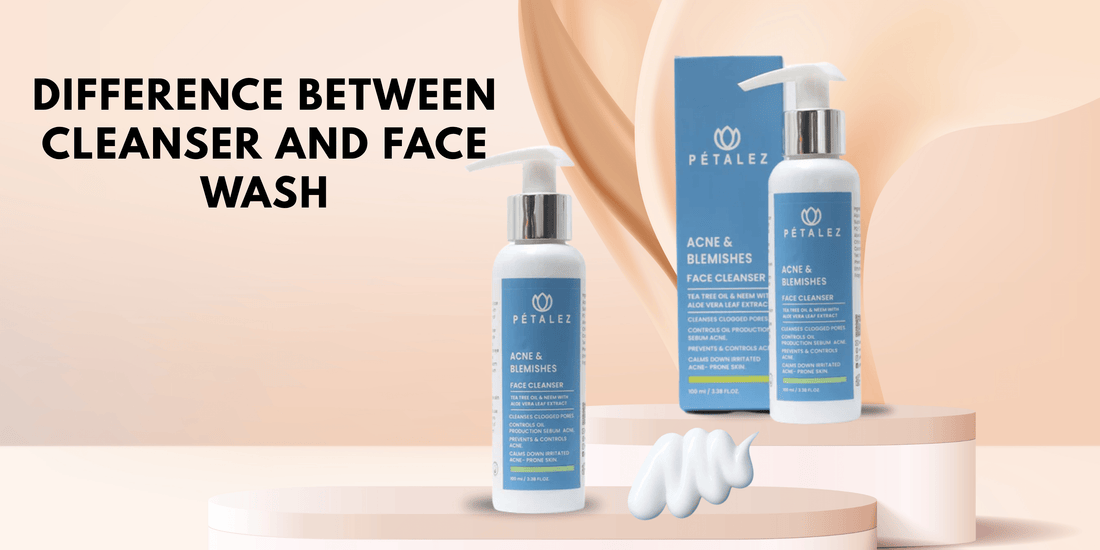
Difference Between Cleanser and Face Wash
Share
Cleansing and washing the face properly is a crucial first step in any skincare routine. However, with so many different formulas on the market, it can be difficult to know when to use a cleanser versus a face wash and whether they’re the same thing. This post will demystify these two essential products, explain when to use each, and help you build a more effective morning and evening regimen. Plus, we’ll guide you on what to look for, including product options like Patlez Cleanser and their price in Pakistan.
Understanding Face Wash vs. Cleanser

What Is a Face Wash?
Texture & Action: Gel‑ or foam‑based, contains surfactants to lift and emulsify oil, dirt, makeup, and sunscreen.
Key Ingredients: Often includes botanical extracts (e.g., aloe vera, chamomile) or active acne‑fighting agents like salicylic acid or benzoyl peroxide.
Use: Rinse off thoroughly to leave skin feeling refreshed and pore‑clean.
What Is a Cleanser?

A broad category that covers multiple gentle formulas, many of which don’t require rinsing:
Micellar Water contains tiny lipid micelles that attract oil and impurities. No‑rinse option; ideal for quick makeup removal or travel.
Cleansing Milk Creamy, lotion‑like texture. Gently dissolves light makeup and surface debris.
Cleansing Oil/Balm Oil‑based, perfect for breaking down heavy makeup and sunscreen. Rinseable or wipe‑off formats are available.
Gel or Foam Cleansers: Water‑based, lightweight, suitable for oily and acne‑prone skin. Foam texture gives a deeper lather without heavy surfactants.
Key Difference: Face washes rely on surfactants for a thorough, lathered cleanse, while cleansers (especially non‑foaming types) remove grime through solubilization and often don’t require rinsing.
Important Link: Why Face Serums Are a Must-Have in Your Skincare Routine
When to Use a Cleanser for Your Face

Cleansers excel at gentle makeup removal, morning refreshers, and second‑step purification:
-
Removes overnight sweat, oil, and environmental residue.
-
Opt for a non‑foaming milk or micellar water to avoid stripping natural oils.
Evening Double Cleanse
-
Step 1: Oil, balm, or micellar water to melt away makeup and sunscreen.
-
Step 2: Water‑based cleanser (gel/foam) to purge any remaining impurities and sweat.
Makeup Remover
-
No‑rinse micellar waters or cleansing oils gently dissolve stubborn waterproof formulas without irritation.
On‑the‑Go or Travel
-
Micellar water or cleansing wipes keep skin fresh when water isn’t available.
Post‑Workout
-
Use a soothing, non‑foaming cleanser to eliminate sweat and bacteria without harming the skin barrier.
When to Use a Face Wash
Face washes are ideal for deeper, surfactant‑powered cleansing:
PM Deep Cleanse
-
After your oil/balm pre‑cleanse, follow with a face wash to whisk away residual impurities.
Oily/Acne‑Prone Skin
-
Daily or twice‑daily use of salicylic acid or benzoyl peroxide formulations helps clear pores and prevent breakouts.
When You Need an Invigorating Ritual
-
A rich lather can feel refreshing and aid in stimulating circulation—just don’t overuse on sensitive or very dry skin
Should You Cleanse Before or After Your Bath?
The timing of your facial cleanse relative to bathing can depend on your skin type:
Dry & Sensitive Skin
-
Before Bath: Cleanse first to protect against steam and hot water stripping away oils.
Oily Skin
-
After Bath: Shower steam can soften pore‑clogging impurities—follow with a gel/foam cleanser to remove loosened oil and sweat.
Conclusion
Understanding the difference between cleansers and face washes empowers you to tailor your routine for maximum benefit:
Cleansers = gentle, no‑rinse (or light‑rinse) makeup/micro‑debris removers
Face Washes = surfactant‑rich, lathered products for deeper pore cleansing
Use them strategically—never both at once—and alternate based on your skin’s needs, time of day, and activity level. This approach ensures a clean, balanced complexion without compromising your skin barrier.
Frequently Asked Questions
Can I use cleanser and face wash together?
No—using both back‑to‑back can be overly stripping. Instead, double cleanse by choosing one gentle makeup‑removing cleanser first, then a deeper‑cleansing face wash.
When should you use micellar water?
Always before your regular cleanser or face wash before to dissolve makeup, oil, and sunscreen and prime the skin for a deeper clean. No need to use it after.
Should I use a face cleanser every day?
Yes—twice daily (AM and PM) cleansing removes oil, impurities, and pollutants. Skipping cleansers can lead to clogged pores and dullness.
What’s the best time to apply cleanser vs. face wash?
-
AM: Use a gentle cleanser upon waking. (e.g., Patlez Cleanser) Upon waking.
-
PM: Double cleanse—start with your makeup‑removing cleanser, then follow with your face wash for a thorough nighttime cleanse.
